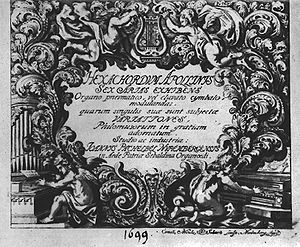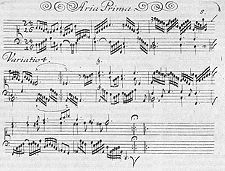
Hexachordum Apollinis
Encyclopedia

Keyboard instrument
A keyboard instrument is a musical instrument which is played using a musical keyboard. The most common of these is the piano. Other widely used keyboard instruments include organs of various types as well as other mechanical, electromechanical and electronic instruments...
music by Johann Pachelbel
Johann Pachelbel
Johann Pachelbel was a German Baroque composer, organist and teacher, who brought the south German organ tradition to its peak. He composed a large body of sacred and secular music, and his contributions to the development of the chorale prelude and fugue have earned him a place among the most...
, published in 1699. It comprises six arias with variations, on original themes, and is generally regarded as one of the pinnacles of Pachelbel's oeuvre. The collection includes a preface in which Pachelbel dedicates the work to Dieterich Buxtehude
Dieterich Buxtehude
Dieterich Buxtehude was a German-Danish organist and composer of the Baroque period. His organ works represent a central part of the standard organ repertoire and are frequently performed at recitals and in church services...
and Ferdinand Tobias Richter
Ferdinand Tobias Richter
Ferdinand Tobias Richter was anAustrian Baroque composer and organist.From 1675 to 1679 Richter served as organist at Heiligenkreuz Abbey in southern Austria. In 1683 he moved to Vienna to become court and chamber organist at the imperial court. In 1690 he was named first organist in the court...
and briefly discusses the nature of music.
General information
Hexachordum Apollinis (the title roughly translates to "Six Strings of Apollo") was published in 1699 in NurembergNuremberg
Nuremberg[p] is a city in the German state of Bavaria, in the administrative region of Middle Franconia. Situated on the Pegnitz river and the Rhine–Main–Danube Canal, it is located about north of Munich and is Franconia's largest city. The population is 505,664...
by Johann Christoph Weigel, a publisher who had worked with Pachelbel before. The frontispiece, created by Cornelius Nicolaus Schurz, describes the collection as "six arias to be played on the organ, or the harpsichord, to whose simple melodies are added variations for the pleasure of Friends of the Muses." The instruments mentioned are referenced on the frontispiece: two cherub
Cherub
A cherub is a type of spiritual being mentioned in the Hebrew Bible and cited later on in the Christian biblical canons, usually associated with the presence of God...
s are pictured, one playing a pipe organ
Pipe organ
The pipe organ is a musical instrument that produces sound by driving pressurized air through pipes selected via a keyboard. Because each organ pipe produces a single pitch, the pipes are provided in sets called ranks, each of which has a common timbre and volume throughout the keyboard compass...
(possibly with a pedalboard
Pedalboard
A pedalboard is a keyboard played with the feet that is usually used to produce the low-pitched bass line of a piece of music...
), the other a single-manual harpsichord
Harpsichord
A harpsichord is a musical instrument played by means of a keyboard. It produces sound by plucking a string when a key is pressed.In the narrow sense, "harpsichord" designates only the large wing-shaped instruments in which the strings are perpendicular to the keyboard...
or clavichord
Clavichord
The clavichord is a European stringed keyboard instrument known from the late Medieval, through the Renaissance, Baroque and Classical eras. Historically, it was widely used as a practice instrument and as an aid to composition, not being loud enough for larger performances. The clavichord produces...
.
Pachelbel wrote a short preface (dated November 20, 1699), in which he dedicated the collection to Dieterich Buxtehude
Dieterich Buxtehude
Dieterich Buxtehude was a German-Danish organist and composer of the Baroque period. His organ works represent a central part of the standard organ repertoire and are frequently performed at recitals and in church services...
and Ferdinand Tobias Richter
Ferdinand Tobias Richter
Ferdinand Tobias Richter was anAustrian Baroque composer and organist.From 1675 to 1679 Richter served as organist at Heiligenkreuz Abbey in southern Austria. In 1683 he moved to Vienna to become court and chamber organist at the imperial court. In 1690 he was named first organist in the court...
and expresses a hope that his eldest son Wilhelm Hieronymus
Wilhelm Hieronymus Pachelbel
Wilhelm Hieronymus Pachelbel was a German composer and organist, elder son of Johann Pachelbel.Born in Erfurt near Eisenach , Pachelbel studied with his father. The first printed reference to either Pachelbel is in Johann Mattheson's Ehrenpforte...
might study with one of them (it is unknown whether this hope was realized). Pachelbel also confesses that "something weightier and more unusual" than this work should have been written for the occasion, apparently feeling that this is not his best work. Pachelbel alludes to the "friendly nature" of Buxtehude and Richter, which might indicate that he knew one of them or both, perhaps through correspondence.
Another topic discussed in the preface is the nature of music. Pachelbel writes that music is the finest of the arts, governing human emotions and desires, and expresses the "belief of many" that music comes from the "Dreymal-Heilig" sung by angels and from the movement of celestial bodies (a belief, Pachelbel points out, shared by Pythagoras
Pythagoras
Pythagoras of Samos was an Ionian Greek philosopher, mathematician, and founder of the religious movement called Pythagoreanism. Most of the information about Pythagoras was written down centuries after he lived, so very little reliable information is known about him...
and Plato
Plato
Plato , was a Classical Greek philosopher, mathematician, student of Socrates, writer of philosophical dialogues, and founder of the Academy in Athens, the first institution of higher learning in the Western world. Along with his mentor, Socrates, and his student, Aristotle, Plato helped to lay the...
). Secular variations were rarely accompanied by such ideas; and apparently there is also a cabalistic
Kabbalah
Kabbalah/Kabala is a discipline and school of thought concerned with the esoteric aspect of Rabbinic Judaism. It was systematized in 11th-13th century Hachmei Provence and Spain, and again after the Expulsion from Spain, in 16th century Ottoman Palestine...
aspect to the collection (Johannes Pachelbelius Organista Noriberghensium = 1699) which has yet to be researched.
Of all published works by Pachelbel, Hexachordum Apollinis had the widest distribution and survives in more than 10 copies in various libraries in Berlin
Berlin
Berlin is the capital city of Germany and is one of the 16 states of Germany. With a population of 3.45 million people, Berlin is Germany's largest city. It is the second most populous city proper and the seventh most populous urban area in the European Union...
, London
London
London is the capital city of :England and the :United Kingdom, the largest metropolitan area in the United Kingdom, and the largest urban zone in the European Union by most measures. Located on the River Thames, London has been a major settlement for two millennia, its history going back to its...
, The Hague
The Hague
The Hague is the capital city of the province of South Holland in the Netherlands. With a population of 500,000 inhabitants , it is the third largest city of the Netherlands, after Amsterdam and Rotterdam...
, Rochester
Rochester, New York
Rochester is a city in Monroe County, New York, south of Lake Ontario in the United States. Known as The World's Image Centre, it was also once known as The Flour City, and more recently as The Flower City...
, and other cities.
Analysis

Girolamo Frescobaldi
Girolamo Frescobaldi was a musician from Ferrara, one of the most important composers of keyboard music in the late Renaissance and early Baroque periods. A child prodigy, Frescobaldi studied under Luzzasco Luzzaschi in Ferrara, but was influenced by a large number of composers, including Ascanio...
's Aria detta la Frescobalda from the 1627 Secondo libro di toccate; of Pachelbel's contemporaries Bernardo Pasquini
Bernardo Pasquini
right|thumb|Bernardo PasquiniBernardo Pasquini was an Italian composer of opera and church music.He was born at Massa in Val di Nievole . He was a pupil of Antonio Cesti and Loreto Vittori...
was one of the main exponents of this trend), and Pachelbel was among the first in Europe to explore the form. The overall plan of Hexachordum Apollinis is as follows:
| Piece | Key | Number of variations |
|---|---|---|
| Aria Prima | D minor | 6 |
| Aria Secunda | E minor | 5 |
| Aria Tertia | F major | 6 |
| Aria Quarta | G minor | 6 |
| Aria Quinta | A minor | 6 |
| Aria Sexta Sebaldina | F minor | 8 |
There is a distinct border between the first five arias and the last one. The first five are arranged so that their keys span a perfect fifth, the keys of a hexachord
Hexachord
In music, a hexachord is a collection of six pitch classes including six-note segments of a scale or tone row. The term was adopted in the Middle Ages and adapted in the twentieth-century in Milton Babbitt's serial theory.-Middle Ages:...
, all are in common time
Common Time
"Common Time" is a science fiction short story written by James Blish. It first appeared in the August 1953 issue of Science Fiction Quarterly and has been reprinted several times: in the 1959 short-story collection Galactic Cluster; in The Testament of Andros ; in The Penguin Science Fiction...
and all but one have 6 variations. According to the old hexachordal principle the sixth aria should've been in B-flat major. Pachelbel does use two flats, as expected, but the work is in F minor. Furthermore, this aria is in triple time and followed by 8 variations. Finally, it has a subtitle, Aria Sebaldina, referring to St. Sebaldus Church
St. Sebaldus Church
St. Sebaldus Church is a medieval church in Nuremberg, Germany. Along with Frauenkirche and St. Lorenz, it is one of the most important churches of the city, and also one of the oldest. It is located at the Albrecht-Dürer-Platz, in front of the old city hall...
in Nuremberg, where Pachelbel was working at the time.
Pachelbel's themes are simple song-like pieces in two sections: four bars in the first section and four or eight in the second. Both sections are repeated. The variations conform to the same structure. Most are in common time (except for Aria Sebaldina, in which all variations are in triple time, like the theme) and explore various constant harmony and melodic outline models. Although the frontispiece indicates that the work is intended for either organ or harpsichord, much of the music is better suited for the latter, particularly the brisé figurations, broken chords, and a number of variations that introduce various non-keyboard styles: the strumming of a plucked string instrument, lute style brisé
Style brisé
Style brisé is a term for broken, arpeggiated texture in instrumental music. It usually refers to French Baroque music for lute, keyboard instruments or the viol. French Baroque musicians referred to this type of texture as style luthé , since it originated in lute music...
, etc. (see Example 1).

Media
External links
-
- include a score of Hexachordum Apollinis, typeset by Johan Tufvesson.

